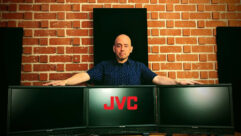
Video Production Hits New Level
Postoperative surgical site infections are a major, unwanted complication in hospitals around the country. The need for proper sterilization of all tools and equipment in the operating room (OR) is imperative. But that need for sterilization increasingly extends to the AV equipment that’s showing up in more and more ORs.
Operating room AVFOR MORE INFORMATION
CHALLENGE: Install a multi-camera fiber optic AV system for live playback and recording in a sterile environment.
SOLUTION: Use wireless technology and AV equipment tough enough to withstand repeated sterilization procedures.
Postoperative surgical site infections are a major, unwanted complication in hospitals around the country. The need for proper sterilization of all tools and equipment in the operating room (OR) is imperative. But that need for sterilization increasingly extends to the AV equipment that’s showing up in more and more ORs.
St. Joseph Medical Center in Towson, MD, is one hospital that has invested in AV technology to further its mission to educate medical professionals and patients in accordance with the highest industry standards. Using an educational grant from DePuy Spine Inc., a Johnson & Johnson company, St. Joseph recently installed a multi-camera HD 1080i video system on a fiber optic backbone for real-time, remote observation of spinal surgeries.
The system in St. Joseph’s OR4East was designed and installed by Gordon MacPherson of Atlantic Video Productions in Middleboro, MA. Previously, MacPherson had used his knowledge and expertise to install a similar AV system for DePuy Spine at a medical facility in San Antonio, TX. This educational visitation site was also a permanent installation with similar remote viewing requirements. “It was a standard definition system connected with FireWire instead of fiber,” he adds. “The length of cable run to the remote conference room really tested the 165-foot capability of the FireWire.”
When DePuy Spine chose Atlantic Video Productions to set up another educational visitation site at St. Joseph, MacPherson worked with Dr. Paul C. McAfee, chief of spinal surgery for the hospital, to improve upon the previous design using more robust technology. “The AV system is amenable to any type of spine surgery,” McAfee says. “We’re a teaching hospital, so the observation room needed to accommodate 30 to 40 people who can see the procedure at any angle.”
Sterilizing AV Equipment
Keeping AV equipment sterile in an operating room (OR) environment is imperative, and can make the difference between life and death. At St. Joseph Medical Center in Towson, MD, production specialists wearing latex gloves sterilize AV equipment using cotton swabs and/or sterile towels and alcohol. The equipment is also exposed to ultra violet (UV) light prior to entry into the sterile corridors of the OR suite. As UV light penetrates the cell walls and cytoplasmic membrane of bacterial microorganisms, it causes a molecular rearrangement of the microorganism’s DNA, which prevents it from reproducing. If the cell can’t reproduce, it’s considered dead.
“There’s no quick way to clean the equipment,” says Gordon MacPherson of Atlantic Video Productions in Middleboro, MA, who designed and installed St. Joseph’s OR4East. “It takes at least a half hour with two production specialists certified by OSHA for blood-borne pathogens to perform this laborious job. So far, the alcohol has had no effect on the equipment, but we’re monitoring this for degradation issues moving forward.”
All surgeries and procedures have a minimum of two production specialists, who are fully versed in medical media production. Tape changes and the moving of the overhead boom camera are constant due to the use of X-Ray machines that are critical to minimally invasive surgery.
The room also needed space for those who would work on demonstration dummies along with the surgery while looking at a video monitor. Two-way audio communication was also important, so observers could ask any questions about the procedure in real time. “We have outside physicians who come in to learn how to do different operations, and the best way to learn is through AV,” McAfee says. “It gives them a feel for the surgery, and the observation room view with video displays is often better than being an assistant in the OR. You can show different views like close-ups, wide angles, or side views. Plus, the high-definition cameras often have a resolution that’s better than an operative microscope.”
The install took place over the course of two Saturdays in 12-hour shifts. Using this time frame, the hospital never really had to shut down the OR. MacPherson and his team dealt with the usual obstacles encountered with a 40-year-old building such as drilling through existing concrete walls; however, additional elements were installed due to the unique nature of the OR. “We added a fire suppression system due to the presence of oxygen,”
MacPherson says. “Cable clutter was also a big issue, so we had to pull out sections of ceiling to install raceways. It was challenging, but we had good planning skills, thanks to our network TV production background.” MacPherson began the install from the observation room and ran the fiber cable toward the OR suite. He budgeted the actual length of the run (700 feet), plus 10 percent for future needs. Special medical-grade sealants were used on all joints, cable openings, and disturbed sections of the perforated OR ceiling. The fiber core runs into a junction box that houses all AV cables and a connection for the portable production cart.
The wheeled, steel Bretford TVCA 3654E4 cart, which must be removed for sterilization after every surgery, contains a Mackie 1202-VLZ Pro mixer, an Edirol V-440 HD video switcher, and a Tapco J-2500 amplifier for two-way communications. Two 20-inch Samsung 204T SyncMaster LCD flat-panel displays used for mix monitors sit atop the production cart.
To get the proper viewing angles, MacPherson installed three Sony HD HVR-Z1U cameras in a halo pattern around the sterile field. “They’re at the 3, 6, and 9 o’clock positions on the walls, mounted on robotic arms suspended 7 to 9 feet above the operating theater,” he explains. “Every camera is secured independently and has its own pan/tilt, focus, and zoom that are controlled by the production specialist.” In total, there are two production specialists in the OR during a surgery.
The fourth Sony camera is mounted on a portable Bogen dolly system using a Crane Cams 200 boom. This setup can be moved anywhere in the OR, but is usually placed above the patient. All parts of the dolly are made of very lightweight aircraft-grade aluminum or titanium. The dolly must be able to immediately move out of the way for an incoming X-Ray machine or crash cart. “Nothing we’re doing can delay procedures or jeopardize the patient’s health in any way,” MacPherson says.
The cameras’ RGBHV video signals are sent through an Edirol V-440 HD switcher, and are then transmitted via a Communications Specialties Pure Digital FiberLink 7220 transmitter unit to a receiver in the observation room. The systems allows for the transmission of high-resolution RGBHV images and stereo audio without signal degradation. “The horizontal and vertical syncing really makes for a high-quality signal,” MacPherson says. “You can easily take images directly from all eight sources of video. The future proofing is in the horizontal-vertical synchronization.”
In the observation room, the Communications Specialties Pure Digital FiberLink 7223 receiver unit feeds the video and audio to a 61-inch NEC 61XM4 plasma display and the house audio system, which is comprised of two Mackie C300z loudspeakers.
FOR MORE INFORMATION
Bogen
www.bogen.com
Bretford
www.bretford.com
Communications Specialties
www.commspecial.com
Crane Cams
www.cranecams.com
Edirol
www.edirol.com
Mackie
www.mackie.com
Samsung
www.samsung.com
Sennheiser
www.sennheiser.com
Sony
www.sony.com
Tapco
www.tapcoworld.com
Tiffen
www.tiffen.com
Back in the OR, MacPherson uses four Sennheiser EW-100 lavaliere wireless microphones to capture and record audio. There’s one microphone each for the lead surgeon (McAfee), the approach surgeon (vascular or neural), head scrub nurse, and back table operator. The microphones were chosen for their sonic quality as well as the ability to withstand the sterilization process after each surgery. “There’s constant ambient noise — from the air filtration system to the suction from the operating table,” MacPherson says. “The type of microphone helps to eliminate high and low sounds. The Sennheisers are so clear that you can hear the ortho bone scrape.”
The AV system is connected into the hospital power system, but also has its own power circuit and panel. To avoid any power disruptions, all Sony cameras are run on battery power using Sony NP-F970 Info Lithium ION batteries that provide 600 to 650 minutes of recording time. Standard camera lenses are used with the exception of a Tiffen protective glass cover to protect against spatter. Each camera has its own ISO tape to capture simultaneous processes.
In a special promotional arrangement, any of the hospital’s 20 medical products vendors can use the AV system and the OR for educational purposes. The vendors will often bring in physicians to observe and learn about their new product or surgical technique. Usually a surgeon will run the meeting to prevent interrupting the surgery at an important or critical time.
McAfee says the system’s benefits were recently demonstrated during a scoliosis operation on a 16-year-old patient whose curvature was so severe it was interfering with his breathing. “It’s the biggest spine operation you can have, and lasts four hours,” he says. “I was using a new technique and rod product. Observing via the AV system, the vendor could get immediate feedback on what instruments they can improve.”
McAfee says that the role of AV in such applications is invaluable. “Think of it this way: There are 10,000 spine surgeons, and they can’t learn any other way than by AV,” he adds. “If you have an experienced spine surgeon, I can usually show them a couple of key things, and they’ll be able to pick up the technique because they know the traditional techniques and can see the differences.”
Learning is taken one step further because the audio and video are produced into a 30- to 60-minute highlight DVD. The footage includes the actual surgery as well as X-Rays of the before and after and photos or footage of rehabilitation. “With the DVD, you can see the long-term impact,” McAfee says. “You can see the progression of the patient’s whole story. The DVD is sent to visitors as an archive of the day, as a PR piece, or to a distributor or rep for training.”
The DVDs have been shown at conferences including the Spine Arthroplasty Society, Scoliosis Research Society, and a recent DePuy Spine meeting. MacPherson’s goal is to develop four to five additional sites throughout the U.S. in the near future, with plans to create two mobile multi-camera HD production units that will use individual fiber optic systems.
McAfee sees St. Joseph as a model for other medical centers, with physicians already coming to visit who want to put these AV systems in their own labs.
Linda Seid Frembes is a freelance writer and PR specialist for the professional AV industry. She can be reached at [email protected].










